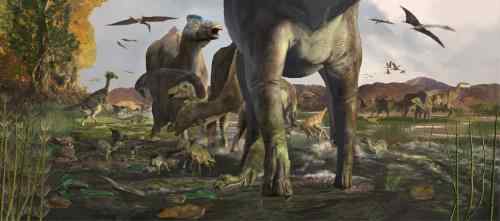Study Says Dinosaur Herds Thrived in Ancient Ecosystem

A trio of paleontologists have discovered a new tracksite in Alaska’s Denali National Park filled with duck-billed dinosaur footprints – technically referred to as hadrosaurs – that demonstrates the animals not only lived in multi-generational herds but thrived in the ancient high-latitude, polar ecosystem.
The paper also provides insight in the herd structure and paleobiology of northern polar dinosaurs in an arctic greenhouse world.
The scientific paper – entitled “Herd Structure In Late Cretaceous Polar Dinosaurs – A Remarkable New Dinosaur Tracksite” – will be published in Geology, the flagship journal produced monthly by the 126-year-old Geological Society of America (GSA).
Anthony R. Fiorillo, Ph.D., the Perot Museum of Nature and Science’s curator of earth sciences and a Fellow of the GSA, is the lead author. Stephen Hasiotis, Ph.D., of the University of Kansas’ Department of Geology – also a Fellow of the GSA – and Yoshitsugu Kobayashi, Ph.D., of the Hokkaido University Museum, are the co-authors. You can read the article, which is now available online at Geology’s website.
It began in 2007, when the trio went on a survey sponsored by the U.S. National Park Service. At that point, the Upper Cretaceous Cantwell Formation in the Alaska Range of Denali had not been explored.
On the last day, perched precariously on the steep side of the mountain, Fiorillo said the three men were giddy when they came upon the wealth of tracks.
“Without question, Denali is one of the best dinosaur footprint localities in the world, but what we found that last day was incredible – so many tracks, so big, and so well preserved,” said Fiorillo.
“Many had skin impressions so we could even see what the bottom of their feet looked like. And there were lots of invertebrate traces – the tracks of bugs, worms, larvae and more – which were important to us because they showed an ecosystem existed during the warm parts of the years.”
Hasiotis adds that the findings told them a lot about how hadrosaurs lived as families within the warmer-than-expected Arctic climate.


